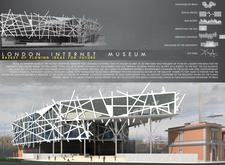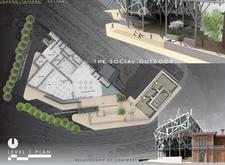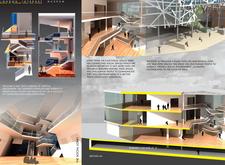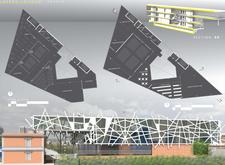5 key facts about this project
**Overview**
The London Internet Museum is situated adjacent to a historic terminal building, designed to address the evolving digital landscape and serve as a hub for innovation and creativity. The museum aims to create a space that reflects the growth of internet culture while fostering community engagement and educational experiences.
**Exterior Expression**
The façade features a complex arrangement of steel and glass, symbolizing the dynamic nature of the digital realm. A series of interwoven white steel beams creates an intricate visual texture that embodies the interconnected essence of the internet. Translucent glass panels not only enhance the aesthetic appeal but also facilitate natural light, contributing to an inviting interior environment.
**Spatial Organization**
The design prioritizes interaction and accessibility through a thoughtfully structured layout. Central to the museum is the Indoor Idea Lobby, designed to encourage informal gatherings and discussions. Surrounding this core space are social areas and terraces that promote visitor engagement and connectivity. Vertical circulation is enhanced by widened staircases, which serve as social connectors, providing opportunities for spontaneous conversations among visitors. Access points are strategically placed to ensure a smooth flow throughout the various exhibition areas, which can be easily reconfigured to accommodate diverse programming and events.
**Material Selection**
The material palette includes steel for structural integrity, translucent glass for daylighting, and concrete brick that connects the new construction to its historical context. Together, these materials establish a dialogue between the contemporary design and the site's legacy, underscoring the museum's role as a forward-looking institution while respecting its environment.





















































